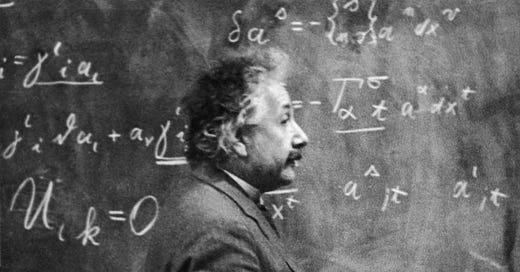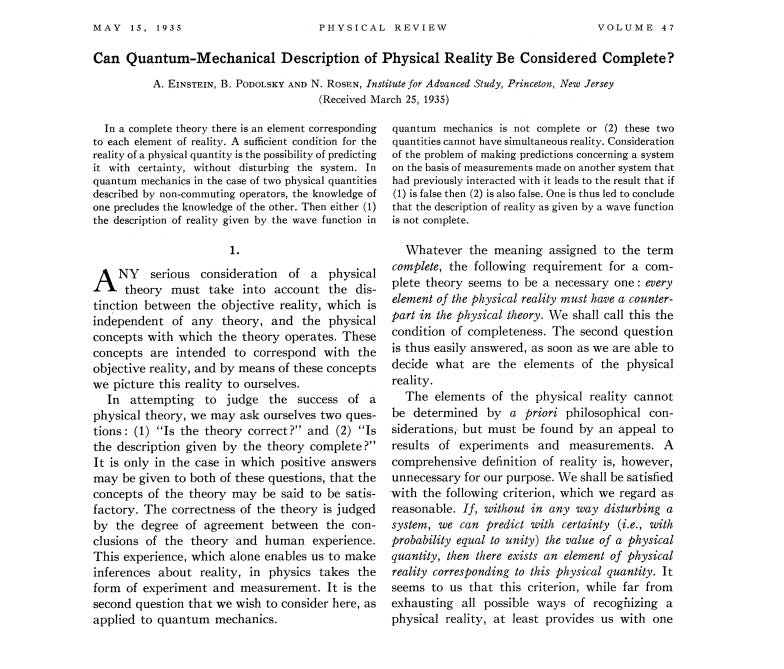The Enigma that puzzled Einstein
Not everything is as it seems. There is something hidden deep inside.
Quantum mechanics forces us to look at things differently. We walk around pretty sure that what we see is true. Instead, what we see may not be what it appears to be. Quite a problem, isn’t it? It is a problem that QM seeks to address. Look, I am here now, sitting on a bench, writing in my notebook. When I look up, I see a lake, and around the lake some trees, and in front of the trees my dog, calm, lying down to sleep. Is what I see real? Is my dog there or is he somewhere else? Certainly it corresponds to what my senses seem to perceive. Classical mechanics describes the world according to laws that we can comprehend and, of course, perceive; a world in which the position and momentum of particles are elements of reality. In QM, however, things are different, and reality is not defined by deterministic, predictable quantities. And for our essentially classical perception of the world, this can be a problem.
The EPR Paper
But what would happen if position and momentum were no longer quantities, but observations? This was also on Einstein’s mind. He began to think about QM as a real way of interpreting the nature of the world in a different way after the Solvay Conference of 1927. Einstein was convinced that physical quantities describing the nature of the world are defined at specific points in space-time. In particular, he was with the principle of locality: Interactions between particles are only possible when they are close to each other. Similarly, forces act only by virtue of proximity, not in the distance. This led Einstein to conclude that QM was fine only in an experimental setting and that it could not be a complete and realistic theory of the physical world. Einstein was so convinced that QM was not suitable for describing physical reality that he wrote a paper with his colleagues Rosen and Podolsky. The article was entitled “Can Quantum Mechanical Description of Physical Reality Be Considered Complete?” but it went down in history as EPR.
EPR prove a general lemma connecting such strict correlations between spatially separated systems to the possession of definite values. On that basis they argue that one cannot maintain both an intuitive condition of local action and the completeness of the quantum description by means of the wave function. This entry describes the lemma and argument of that 1935 paper, considers several different versions and reactions, and explores the ongoing significance of the issues raised. [here]
Alice and Bob
In the EPR paper (Einstein-Podolsky-Rosen Paradox), the three physicists addressed the problem of the position and momentum of two particles moving in opposite directions and established that the interaction between the two particles could not violate the principle of locality, which was also related to the physical limit represented by the speed of light.
The problem is that in a quantum system, the two particles can be in a state of entanglement, which allows them to interact even at great distances and, most importantly, in the instant. Einstein found this interaction disturbing. Imagine that two people, Alice and Bob, each take a particle. Alice takes the first particle and Bob takes the second. The particles start out with a certain spin (form of angular momentum):
When an electron is measured it could be in either of the following states:
|↑⟩ = spin up → clockwise
|↓⟩ = spin down → anticlockwise
What this means is that our electron can “have” angular momentum that makes it seem either spinning clockwise or anticlockwise. It’s always one of the two. Never both (or at least so we thought). [here]
Neither Alice nor Bob measures this spin, and in the meantime they move apart; perhaps light years apart. The two particles are entangled, and this state of entanglement does not weaken with distance. Until Alice and Bob observe the spin state of their particle, the overall quantum state of the system does not change. Never.
Not here but now
So Alice and Bob reach their destination, the two planets where they belong, light years apart. Alice observes her particle, and she gets a spin up. Since Bob’s particle is entangled with Alice’s, Bob will observe the exact same result: his particle will also have a spin up. Whenever Bob decides to measure, he is going to get the same result as Alice did. According to Relativity, signals cannot travel faster than the speed of light. But according to QM, a measurement made by Alice here and now has an instantaneous effect on Bob’s particle, even if it is light years away, because once they are in a state of entanglement, the two particles will remain connected to each other, no matter how far apart they are.
QM violates the law of Relativity, but obeys the law of Relativity?
But then, if two particles in entanglement can communicate instantaneously, why don’t we use this extraordinary potential of theirs to send us information that travels faster than light? Because Alice would have to use conventional means to communicate with Bob. And conventional means cannot travel faster than light. It would not be possible to send information from one particle to another even by manipulating the initial results. The no-communication theorem is a principle of QM that states that a pair of particles cannot practically be used to transmit information from one point to another at speeds greater than light. So QM violates the law of Relativity, but obeys the law of Relativity. But how can the two particles communicate with one another? Without any determination of space or momentum, without any prior determination of anything, without even the observation of their spin when they are close together. Well, this is exactly what puzzled Einstein.
Insights
Albert Einstein, Boris Podolsky, Nathan Rosen, Can Quantum-Mechanical Description of Physical Reality Be Considered Complete? (2022, Claus Kiefer).
A. Douglas Stone, 2015, “Einstein and the Quantum: The Quest of the Valiant Swabian”, The untold story of Albert Einstein's role as the father of quantum theory, Princeton University Press. [here]
Sean Carroll, 2019, “Something Deeply Hidden”. [here]
Bacciagaluppi, G. and A. Valentini, 2009, Quantum Theory at the Crossroads: Reconsidering the 1927 Solvay Conference, Cambridge: Cambridge University Press.
Beller, M., 1999, Quantum Dialogue: The Making of a Revolution, Chicago: University of Chicago Press.
Halvorson, H., 2000, “The Einstein-Podolsky-Rosen state maximally violates Bell’s inequality”, Letters in Mathematical Physics.
Holland, P., 2005, “What’s wrong with Einstein’s 1927 hidden-variable interpretation of quantum mechanics?”, Foundations of Physics, 35: 177–196.






Not a problem. Schrödinger was deeply sceptical of quantum physics. He invented his thought experiment about his quantum cat as a means to show how paradoxical quantum mechanics was. Perversely Heisenberg’s Matrix Mechanics shows very clearly the nature of reality and that position and momentum are derivatives of the quantum matrix object.
It has always interested me that Heisenberg’s Matrix Mechanics was so quickly sidelined by Schrodinger’s wave mechanics. Heisenbergs matrix math is still useful to QM but Schodinger’s wave equation is far less abstract and seems to have captured the momentum. I find this disappointing because matrices also form central roles in AI and describing the graphs that model the connections in associative networks in like our own which seems like a big hint from nature. But matrix mechanics is conceptually hard to grasp and so wave / particle duality has guided our understanding.